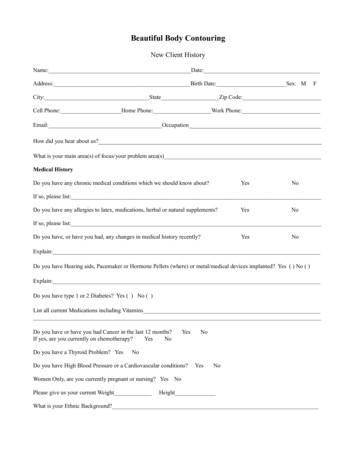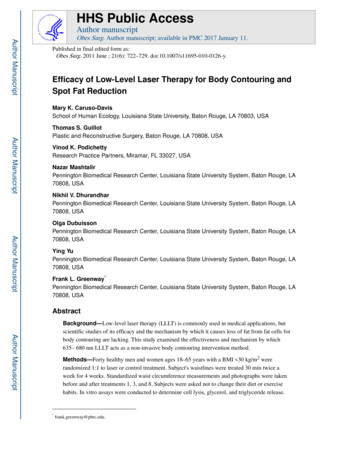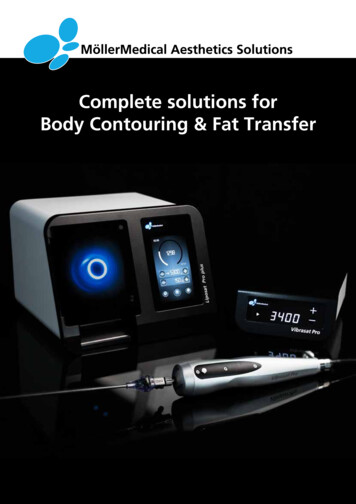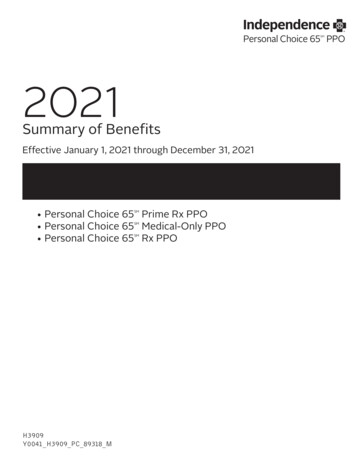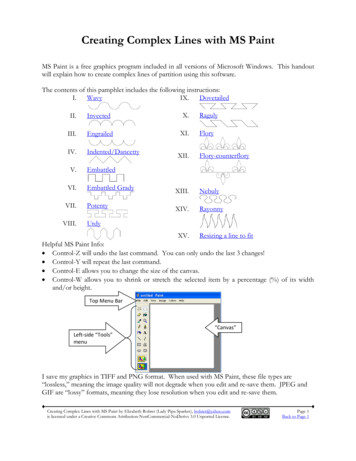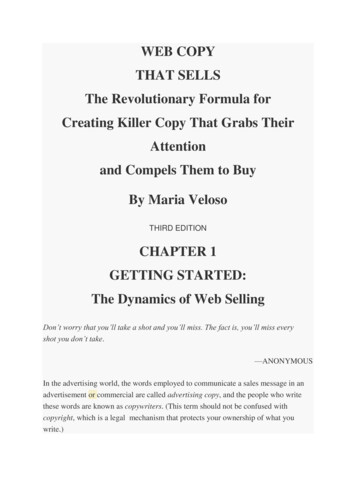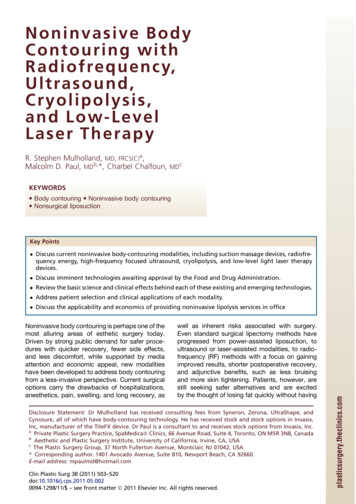
Transcription
Author's personal copyNon inv asi ve BodyCon tour ing withRadiofre quency,Ultraso und,Cryoli pol y sis ,and Low-Le ve lLaser The ra pyR. Stephen Mulholland, MD, FRCS(C)a,Malcolm D. Paul, MDb,*, Charbel Chalfoun, MDcKEYWORDS! Body contouring ! Noninvasive body contouring! Nonsurgical liposuctionKey Points! Discuss current noninvasive body-contouring modalities, including suction massage devices, radiofrequency energy, high-frequency focused ultrasound, cryolipolysis, and low-level light laser therapydevices.! Discuss imminent technologies awaiting approval by the Food and Drug Administration.! Review the basic science and clinical effects behind each of these existing and emerging technologies.! Address patient selection and clinical applications of each modality.Noninvasive body contouring is perhaps one of themost alluring areas of esthetic surgery today.Driven by strong public demand for safer procedures with quicker recovery, fewer side effects,and less discomfort, while supported by mediaattention and economic appeal, new modalitieshave been developed to address body contouringfrom a less-invasive perspective. Current surgicaloptions carry the drawbacks of hospitalizations,anesthetics, pain, swelling, and long recovery, aswell as inherent risks associated with surgery.Even standard surgical lipectomy methods haveprogressed from power-assisted liposuction, toultrasound or laser-assisted modalities, to radiofrequency (RF) methods with a focus on gainingimproved results, shorter postoperative recovery,and adjunctive benefits, such as less bruisingand more skin tightening. Patients, however, arestill seeking safer alternatives and are excitedby the thought of losing fat quickly without havingDisclosure Statement: Dr Mulholland has received consulting fees from Syneron, Zerona, UltraShape, andCynosure, all of which have body-contouring technology. He has received stock and stock options in Invasix,Inc, manufacturer of the TiteFX device. Dr Paul is a consultant to and receives stock options from Invasix, Inc.aPrivate Plastic Surgery Practice, SpaMedica! Clinics, 66 Avenue Road, Suite 4, Toronto, ON M5R 3N8, CanadabAesthetic and Plastic Surgery Institute, University of California, Irvine, CA, USAcThe Plastic Surgery Group, 37 North Fullerton Avenue, Montclair, NJ 07042, USA* Corresponding author. 1401 Avocado Avenue, Suite 810, Newport Beach, CA 92660.E-mail address: mpaulmd@hotmail.comClin Plastic Surg 38 (2011) / – see front matter " 2011 Elsevier Inc. All rights reserved.plasticsurgery.theclinics.com! Discuss the applicability and economics of providing noninvasive lipolysis services in office
Author's personal copy504Mulholland et alto undergo surgery. Several technologies haveemerged to attempt to address these concernsand propose a noninvasive, transcutaneous deliveryof energy for lipolysis.CELLULITE REDUCTION AND FATCELL REDUCTIONPlastic surgeons have had a long and pioneeringhistory in the art and science of body contouring.From the advent of liposuction in the late 1970sand early 1980s, the practice of body contouringhas seen the growth of less-invasive and moreeffective liposuction techniques. When one combines men and women together, liposuction is stillthe most common surgery performed by estheticplastic surgeons in North America1 and liposuction remains the number one esthetic procedureperformed by plastic and cosmetic physiciansworldwide. In 2009, it was estimated that therewere 700,000 liposuction procedures performedin the United States (approximately 500,000 byboard-certified plastic surgeons and the rest bycosmetic physicians) or 4% of all elective surgeries.2 The number of liposuctions is anticipatedto double over the next 4 years to 1.5 million procedures or 8% of all elective operations in UnitedStates.3 This growth in body-contouring surgeryis reflective in general of the expansion in thebody mass index (BMI) of the average North American. The BMI and average weight of North Americans is increasing at an alarming rate; in fact,obesity is one of the most challenging epidemicsfacing North American health care. Fully 30% ofAmericans have a BMI higher than 30 and another30% have a BMI between 27 and 30, making morethan 200 million Americans candidates for weightloss programs and focal or generalized bodycontouring procedures when weight loss has beenachieved.4 Some experts project that by 2015,75% of adults will be overweight, with 41% obese.5Increasing numbers of consumers desiring esthetic body-contouring changes are seekingless-invasive, less-traumatic, and more-effectiveprocedures than traditional suction-assisted liposuction (SAL). Although, SAL is still perceivedas the gold standard in nonexcisional bodycontouring techniques by most plastic surgeons,recent developments in energy-based liposuction,including third-generation ultrasound (UAL), laserassisted lipolysis (LAL), and RF-assisted liposuction(RFAL) may offer reduced ecchymosis, swelling,pain, and enhanced skin contraction when comparedwith SAL.6–9However, as popular as the various forms ofliposuction remain, the fastest growth marketsegment in esthetic medicine is in the area ofnoninvasive body contouring.10 This reflects theunderlying paradigm of many patients: that anysurgery, no matter how “minimally invasive,” isnot what they want. As this timely issue in Clinicsin Plastic Surgery is devoted to noninvasive andminimally invasive esthetic techniques, it is important that the modern plastic surgeon and thespecialty of plastic surgery in general, be wellversed in the various nonsurgical procedures andtechnologies that patients may use to enhancetheir figure and form, or, increasingly, offer thesemodalities in conjunction with their surgical bodycontouring practice. In 2009, the global market forall body-shaping platforms was expected to reach 361.9 billion with more than 9 million proceduresperformed.10 The annual growth in noninvasivebody-contouring procedures is estimated to expand by 21% per year.10This article focuses on the noninvasive bodycontouring modalities that have become availablein the US and North American markets over thepast few years, as well as those that are imminent(selling worldwide but pending approval by theFood and Drug Administration [FDA]). We reviewthe basic science and peer-reviewed articles onclinical outcomes. At the conclusion of the article,some basic business models on incorporatingnoninvasive body-contouring procedures into anesthetic plastic surgery practice are discussed.It is an exciting time in esthetic plastic surgeryand the growth in noninvasive plastic surgery techniques affords the forward-thinking plastic surgeonthe opportunity to treat many more patients whoeither are not ready for invasive techniques or willnever consider incisional plastic surgery. We hopethis article provides a solid basis for understandingthe noninvasive body-contouring options availablein 2010.CLASSIFICATION OF NONINVASIVEBODY-CONTOURING TECHNOLOGYOver the past 5 to 10 years, there has been considerable growth in body size and patient BMI, both inNorth America and worldwide, which has coincidedwith market growth and advances in the technologydevoted to the nonsurgical management of fat andbody contouring. Just as liposuction is the numberone cosmetic plastic surgery procedure performedworldwide, noninvasive body-contouring technology is the fastest growing segment of the estheticcapital equipment space.10 In classifying the technologies related to noninvasive body contouring,we have decided to classify on the basis of thetype of energy delivered by a particular technologyin modifying the adipocyte. There are many excitingadvances in body-contouring technology involving
Author's personal copyNoninvasive Body Contouringthe transepidermal delivery of energy targeting theadipocyte.Classification1. Suction: Massage Devicesa. Endermologie2. Suction-Massage: Thermal Devicesa. TriActive (Cynosure, Inc., Westford, MA, USA)b. Smoothshapes (Cynosure, Inc., Westford,MA, USA)3. Radiofrequency Energy Devicesa. VelaSmooth, VelaShape (Syneron, Inc., Irvine,CA, USA)b. Thermage# (Solta Medical, Hayward, CA,USA)c. Accent (Alma Lasers Inc, Buffalo Grove, IL,USA)d. TiteFX (Invasix, Inc., Yokneam, Israel)4. High-Frequency Focused Ultrasound EnergyDevicesa. UltraShape (UltraShape Ltd., Yoqneam, Israel)b. LipoSonix (Medicis, Scottsdale, AZ, USA)5. Cryolipolysis Energy Devicesa. Zeltiq (Zeltiq Aesthetics, Pleasanton, CA, USA)6. Low-Level Light Laser Therapy Devicesa. Zerona (Erchonia Medical, McKinney, TX, USA)With the classification of noninvasive body contouring based on the kind of energy delivered tothe adipocyte, we focus on the following: basicscience, clinical results, and complications forthose technologies that are the most relevant,peer reviewed, market proven, or exciting.BASIC SCIENCEThe basic science of noninvasive body contouringis really the basic science of the adipocyte, itsstorage of triglyceride, and the aggregate numberof adipocytes as they relate to the focal and generalized excess of adipose tissue, the convex distension that forms the focal “bulges,” and moresuperficially, clinical cellulite topographically. Theadipocyte is a very important cell involved inenergy storage, hormonal regulation, and a hostof other endocrinological functions. The adipocytehas a large amount of cytoplasm that serves as astorage depot for triglycerides, which are composed of glycerol and free fatty acids. The adiposecell is our intermediate and long-term energy storage depot. When caloric intake exceeds caloricoutput, adipocytes then swell with triglycerides.As adipocytes continue to enlarge within their intralobular and interlobular fascial compartments,they create “bulges” or convex distensions ofsoft tissue that then modify our contours. Typicalconvex distensions that one sees in the femaletopography are “out-pouching,” “bulges,” or convex distensions of the hips, lower abdomen, outerthighs, inner thighs, inner knees, arms, and braline. For men, the typical android distributionof subcutaneous adipose-derived convex distensions commonly include the flanks (love handles),lower abdomen, “spare tire,” male fatty breasttissue, and the submentum.Historically and currently, the gold standard forbody contouring still remains the various techniquesof liposuction. Great advances of liposuction havemade this a much less invasive procedure, andthis issue of Clinics in Plastic Surgery deals withsome of the newer energy-based liposuction technologies such as RF-assisted liposuction and laserlipolysis. However, even though liposuction hasbecome less invasive and more amenable tooutpatient procedures, it is still a procedure thatrequires surgical instrumentation under the skinand has risk and morbidity in recovery. Manypatients, no matter how less invasive liposuctionmay appear, will not submit, nor are they interestedin a liposuction procedure. Many patients seek mildto moderate body contour improvements throughdiet and exercise and adjunctive noninvasivebody-contouring procedures. We focus on thetechnologies that have the most peer-revieweddata and literature, and appear the most promisingfor long-term management of focal convex distension of adipose tissue, as well as for generalizedfigure and shape.The basic science of the noninvasive modulationand modification of the adipocyte involves one ofseveral mechanisms (which will be dealt with inmore detail in the Clinical Results and Outcomesof Specific Technologies section). In one mechanism, the adipocyte experiences a periadipocytethermal environment induced by transepidermaldelivery of some energy and this heat increasesthe localized metabolic rate of the fat, evacuating,enhancing, and augmenting the natural egress oftriglyceride out of the fat cell, resulting in a diminishment of the convex distension. Overlying this,there is also some thermal-related dermal tightening with these transepidermal body-contouringheating devices and a measurable circumferentialreduction in fat. Most of these thermal technologies do not, in fact, kill the fat cell. Some technologies deploy energy, either a pulse of high-voltageRF current, or a focused high-frequency ultrasound energy experience that disables or destroysthe adipocyte by permanently damaging the cellmembrane, or coagulating or disrupting and releasing the adipocyte cell contents. And yet othertechnologies, such as low-level light laser therapy,create temporary disruptions in the cell membraneof the adipocyte allowing a temporary egress505
Author's personal copy506Mulholland et alof the triglyceride from the cytoplasm, but the cellmembrane then rights itself again. So, through thesemechanisms, either thermal augmentation of normalmetabolic pathways, thermal destruction, cavitational destruction, or an energy cascade and creation of a temporary adipocyte cell membrane pore,the final result is that the sizes of the adipocytesare either temporarily or permanently reduced and/or the number of adipocytes are reduced, whichwhen translated over hundreds of thousands ormillions of fat cells, will result in a measurable reduction of fat and a circumferential reduction of the bodycontour area in the treated area.INDICATIONS AND CONTRAINDICATIONSOF NONINVASIVE BODY CONTOURINGIn general, all the noninvasive body-contouringtechnologies share the same relative indicationsand contraindications for treatment.Indications include realistic expectations of amodest reduction of localized fat, modest cellulite improvement, compliance with multiple visits,reasonable BMI and lifestyle, and are opposed to asurgical procedure, which would get a better result.Contraindications include if the patient is pregnant, has a pacemaker, is medically unwell, hasunrealistic expectations, or has a large BMI.Proper Patient PreparationWith all body-contouring technologies, it is important to take consistent before-and-after photographs, make circumference measurements, andrecord weight change at each follow-up visit todocument results and ensure the patient is notgaining weight because of a poor diet or lack ofexercise. A proper consent should be executed.The patient’s target treatment areas are assessed and marked in a similar way as for patientsundergoing liposuction. When assessing andmarking the targeted treatment area, the patientshould stand straight up and look forward. Softtissue deformities (unwanted fat deposits) shouldbe evaluated from multiple views for best assessment. Palpate the perimeter of the area to identifyexactly where the deformity begins and mark theprecise area for treatment with a single line. Onlysoft tissue deformities with at least 1.5 cm of fatthickness should be treated and not the adjacentflat or concave areas.CLINICAL RESULTS AND OUTCOMESOF SPECIFIC TECHNOLOGIESSuction/Massage DevicesThe first class of body-contouring technologyemerged approximately 15 to 20 years ago.Endermology is a suction/massage device manufactured in France. The device uses a mechanicalsuction and roller applicator used to pass overfatty areas of the body and cellulitic regions. Thereare peer-reviewed articles in the literature thatshow that in selected patients, particularly thosewith edematous type fatty tissue, endermologycan result in measurable circumferential reduction.Endermology is often combined with increasedexercise, caloric restriction, and increased waterintake.11 Although endermology is popular in theday spa environment, it has very mild, modestclinical effects and has had minimal penetrationin the physician market. The indications are ratherlimited and more than 16 treatments are required,which last longer than 30 minutes, and thus it is notproven to be an optimal revenue generator norsuccessful in plastic surgery and physician offices.Suction/Massage and Energy DevicesAugmenting the concepts of endermology aredevices from several companies that use suctionrollers in combination with transepidermal thermalenergy. These devices will deploy diode arrays ordiodes/nonfocused ultrasound around the applicator head that is then passed over the fatty areasof the body, such as TriActive and SmoothShapes(Cynosure, Inc., Westford, MA, USA) (Fig. 1). Again,results are mild to modest in effect and generallyhave not been incorporated into many practicesfor full-scale noninvasive body contouring.Radiofrequency Energy DevicesThe RF energy devices currently dominate theworldwide noninvasive body-contouring devicemarket.10 The first serious noninvasive bodycontouring device that was widely incorporated inphysicians’ practices was the VelaSmooth (Syneron), followed 2 years later by the VelaShape. Thiswas followed by other RF body-contouring devices,including Thermage# (Solta Medical, Hayward, CA,USA), Accent (Alma Lasers), TriPollar (Pollogen, TelAviv, Israel), Freeze (Venus Concepts, Karmiel,Israel) and most recently TiteFX (Invasix).VelaSmooth and VelaShapeIn 2005, the VelaSmooth became the first energybased medical device to be approved by the FDAfor reducing the appearance of cellulite. In September 2007, VelaShape became the first FDAapproved noninvasive device for both celluliteand circumference reduction.Device description Both VelaSmooth and VelaShape systems combine controlled 700-nm to2000-nm infrared (IR) light and suction couple–
Author's personal copyNoninvasive Body ContouringFig. 1. TriActive device. (From Cynosure; with permission.)conducted bipolar RF (1 MHz) energies with mechanical manipulation. Conductive RF energy isapplied externally by suction coupling 2 electrodesto the skin surface. Both the geometry of the electrodes and the conductive RF pulse duration areoptimized for safe heating of the skin. The use ofconductive RF allows for a reduction in the necessary optical energy applied to the skin. Furthermore, this form of energy is not sensitive to skinpigmentation and therefore its use is advantageous in treating all skin types.These systems are composed of a base unit towhich 2 different applicators (large and small) maybe connected (Fig. 2). The applicators are equivalent in their power density and each is fitted to thebase unit via a replaceable cap. During treatment,the applied suction repeatedly pulls the skin intoa chamber in the middle of the treatment cavity,where the skin is exposed to IR light and RF whileits surface temperature is being monitored. Thesystem enables the user to adjust the RF energyFig. 2. VelaShape VSII device. (From Syneron and CandelaScience; with permission.)and optical energy levels, thereby using the optimaltreatment parameters for each subject/anatomicarea.Mechanism of action The VelaSmooth and Vela-Shape mechanism of action is based on a novelcombination of suction-coupled bipolar RF andoptical energies delivered to the dermis/hypodermis zones. Optical IR energy targets mainlythe dermal water, whereas the RF energy targetsthe hypodermis by controlled thermal stress.Applying thermal energy to the dermis causesdermal tightening and contraction but also activates a cascade of physiologic responses inside507
Author's personal copy508Mulholland et althe dermal fibroblasts (the cells that produce collagen) to stimulate and promote neocollagenesis(new collagen formation). Neocollagenesis is further potentiated by increased dermal vascularitysecondary to the thermal stress induced. Thevacuum potentiates neocollagenesis via themechanical stress imposed on dermal fibroblasts.Neocollagenesis and collagen contraction furthercontribute to enrichment and strengthening ofthe otherwise loose connective tissue fibrous septae. Applying the bipolar RF energy to the hypodermis increases fat cells’ metabolism andaccelerated triglyceride egress from the cell.Increased tissue temperature increases vascularperfusion, which further enhances lipid turnoverowing to increased oxygen content. Increasedlipid turnover results in fat cell shrinkage andreduced fat tissue volume, a circumferentialreduction, and an esthetic reduction in the convexdistension. Vacuum and mechanical massageincrease blood vessel and lymphatic circulationand lymphatic drainage, which further contributeto lipid turnover and fat cell redistributionthroughout the body. The resulting simultaneousincrease in the dermal collagen and groundsubstance content, connective tissue architecture,and the decrease in subcutaneous fat tissue volumeallow for optimal circumferential reduction andimprovement in cellulite appearance.As the VelaShape and VelaSmooth have longterm placements in the physician market, there isgood peer-reviewed evidence of their efficacy forboth the treatment and temporary reduction ofcellulite and fat.Clinical VelaSmooth and VelaShape results In thelargest study of VelaSmooth to date, Sadick andMulholland12 evaluated 35 patients who completed either 8 or 16 treatments with VelaSmooth.Clinical improvement as evaluated by a blindeddermatologist revealed an average of 40% improvement in the appearance of cellulite and ameasurable circumferential reduction in all.Alster and Tanzi13 conducted a self-controlstudy, including 20 women patients who received3 biweekly VelaSmooth treatments for thigh andbuttock cellulite. Ninety percent of the patientsnoticed overall clinical improvement and side effectswere limited to transient erythema in most patients.A longer follow-up study performed by Kulick14evaluated the degree of improvement 3 and 6months after the last session of treatment. According to the blinded physician evaluators, all patientswere improved at both posttreatment periodswith an average of 62% and 50% improvement at the 3-month and 6-month follow-up,respectively.Another long follow-up study conducted in anAsian population found a significant reduction inthigh and abdomen circumferences up to 1 year aftertreatment. At 4 weeks after the last treatment, theaverage circumference reductions of the abdomenand thigh were sustained at 3.17 " 2.75 cm and3.50 " 2.04 cm, respectively. At the 1-year followup visit, the average circumference reductions ofthe abdomen and thigh were maintained at 3.83 "0.76 cm and 3.13 " 3.54, respectively. The averageclinical improvement scores of the abdomen andthigh after the series of treatments were 0.75 (corresponding to w25% improvement) and 1.75 (corresponding to w50% improvement), respectively.15More recently, Sadick and Magro16 found astatistically significant decrease in thigh circumference at 4 weeks after VelaSmooth treatments, butno immediate change or a persistent decrease at8 weeks after the procedure. Nevertheless, itshould be noted that the main indication for usingVelaSmooth is improving cellulite appearance, andof all available RF devices, only VelaSmooth hasbeen approved by the FDA specifically for cellulitetreatment.Winter17 evaluated the performance of the higherpower version of this technology (VelaShape with50 W as opposed to VelaSmooth with 25 W) forbody reshaping and improvement of skin texture/laxity in postpartum women. In this study, 20 womenreceived 5 weekly treatments to the abdomen,buttocks, and thighs with the VelaShape system.The overall mean circumference reduction was5.4 " 0.7 cm (P .001). Significant (P .02) improvement in skin laxity and tightening was noted by boththe physician and patients. Treatments were welltolerated with no major safety concerns (1 purpura,1 mild burn).In a recent study, Brightman and colleagues18revealed the clinical efficacy and the molecularmechanisms underlying treatments with VelaShape. Nineteen subjects underwent 5 weeklytreatments of the upper arms, and 10 subjectsunderwent 4 weekly treatments of the abdomenand flanks. Change in arm circumference, at thefifth treatment was statistically significant witha mean loss of 0.625 cm. At 1-month and 3-monthfollow-ups, mean loss was 0.710 and 0.597 cmrespectively. Reduction of abdominal circumference at the third treatment was statistically significant with a 1.25 cm mean loss. At 1-month and3-month follow-ups, average loss was 1.43 and1.82 cm respectively. Furthermore, the sustainablereduction in circumferences and the significantimprovement in the appearance of the arms andabdomen correlated with significant morphologicand histologic changes observed in biopsies obtained in vivo from the treated areas.
Author's personal copyNoninvasive Body ContouringIn summary, there are many peer-reviewedarticles to support the clinical efficacy and safetyof using the combined bipolar RF, IR, and mechanical manipulation technology for cellulite improvement and circumference reduction in awide variety of patient populations. The clinicaland molecular data presented here further supportthe concept that the underlying mechanism ofaction for improved skin laxity and volume reduction is based on controlled RF and IR thermalmodification of the dermal/hypodermal layers.ThermageTM body and accentThere are 2 common monopolar RF devices sold inthe marketing place, Thermage# (Solta Medical,Hayward, CA, USA) and Accent (Alma Lasers).Both of these devices are discussed extensivelyin the RF for Skin Tightening article by Mulhollandelsewhere in this issue. Thermage# has had anFDA-cleared body tip since 2006 and Accent hashad body clearance for more than 2 years. Themonopolar RF in these systems is not suctioncoupled and there is no adjunctive optical energysource as in the VelaShape. Thermage# RFbody treatments have been shown in the animaland human biopsy model to result in lysis of theadipocyte membrane when high enough energiesare deployed.19 Thermage# has been assessedin the treatment of cellulite with improvementscores of 30% to 70% and in treatment of stretchmarks with improvement scores of 20% to 80%,when measured at least 6 months following treatment, depending on the study.20–22 Thermage#monopolar RF body treatment has also demonstrated moderate average circumferential reduction and fat-thickness reduction at 6 monthsfollowing one or more treatments.20 Accent isanother monopolar RF system that operates ata high frequency and has shown improvement withnoninvasive monopolar RF treatments of celluliteand fat reduction.23,24 TriPollar (Pollogen, Tel Aviv,Israel) and Freeze (Venus Concepts) have 3 to 8 RFelectrodes and show early promise for temporaryadipocyte reduction and skin tightening.25TiteFX: RF and high-voltage pulseelectroporationThe TiteFX is an interesting emerging bodycontouring technology that differentiates itself fromother RF technologies, which (except in animalstudies) use lower tissue levels of RF to metabolically enhance the triglyceride processing out ofthe adipocyte but not permanently kill or damagethe fat cell and so the focal lipodystrophy or celluliteis more prone to recurrence. TiteFX uses suctioncoupled RF to preheat the dermis and first 15 to20 mm of fat and uses a precise thermistor builtinside the suction cavity to monitor the uniformand even skin temperature and suction distribution.When the epidermal temperature reaches thedesired level, usually 43 to 45# C, a high-voltage,electroporation pulse is generated through theadipose tissue resulting in an high voltage electroporation apoptocysis, or death of the fat cell overthe following week.26The device is very fast and the temperaturesvery uniform, making the treatment more tolerable than other RF systems that develop thermal“hot spots” and pain. With the TiteFX, like thehigh-intensity focused ultrasound (HIFU) family,a significant portion of the adipocyte populationis targeted for cell death and thus the bodycontouring circumferential reductions and celluliteimprovements are more long term or permanentthan other RF technologies.26 TiteFX comes witha noninvasive fat-contouring and cellulite applicator, as well as a noninvasive face-tighteninghand piece.High-Frequency Focused UltrasoundEnergy DevicesThe HIFU noninvasive body-contouring devices,UltraShape and LipoSonix, have received a lot ofmedia attention and both have been sold in manymarkets around the world, including Canada, butare awaiting FDA clearance. They are excitingtechnologies and, like Zeltiq and TiteFX, theyboth result in noninvasive adipocyte death, ratherthan just metabolic amplification of the fat cellmetabolism and, as such, may offer long-termnoninvasive body-contouring results. Many physicians around the world are achieving good bodycontour results and have profitable body-contourprograms using HIFU.However, there are many noninvasive, nonfocused ultrasound devices on the market, such asProslimelt (Medical Care Consulting, Murten,Switzerland), Medcontour (General Project, Florence, Italy), Ultracontour (Medixsysteme, Nimes,France), Novashape (Ultra Med, Milton, ON, Canada),Accent Ultra (Alma, Buffalo Grove, IL, USA), VaserShape (Sound Surgical Technologies, Louisville,CO, USA), or the so-called “Ultracavitors,” thatclaim to have an effect on the fat cell, but thereis no known published scientific, preclinical, orclinical data to support such claims. Most of thesedevices use a variation of standard physiotherapyultrasound technology indicated for diathermy,combined with some type of massage or vacuum.The nonfocused ultrasound simply heats theunderlying skin and tissue just as any standardphysiotherapy ultrasound device. These devicesdo not meet the requirements to produce focused509
Author's personal copy510Mulholland et alultrasound; therefore, they cannot increase maximalpressure deep without causing skin damage. Thelikelihood for cavitation is characterized by themechanical index (MI), and based on the ultrasoundspecifications of these devices, they do not meet theminimum MI and pressure threshold for cavitation infat; therefore, they do not disrupt fat cells. Thesephysiotherapeutic ultrasound devices are not newto plastic surgeons, as they are similar to theexternal-assist UAL technologies of the early1990s. These devices may create a temporary effectbut there is no known scientific or preclinicalevidence (histology or gross pathology) of fat celldisru
history in the art and science of body contouring. From the advent of liposuction in the late 1970s and early 1980s, the practice of body contouring has seen the growth of less-invasive and more-effective liposuction techniques. When one com-bines men and women together, liposucti
